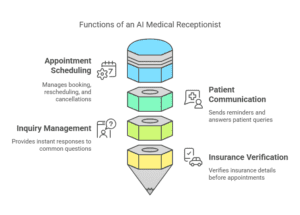On-Demand Outsourcing BPO Services for Healthcare Providers With 24/7 Coverage!
Save up to 70% on staffing costs!
Browse Specialty Staffing ServicesWhy Every Healthcare Practice Needs an AI Medical Receptionist Today?

AI Medical Receptionists are transforming how healthcare practices manage their daily operations. As clinics and hospitals face growing demands, finding ways to optimize workflows has become more important than ever. These innovative solutions offer improved efficiency, cost savings, and better patient satisfaction. If you’ve been wondering how to streamline your practice without sacrificing quality care, integrating AI Medical Receptionists could be the answer.
In this blog, we’ll cover everything you need to know—from the key functions of these AI-driven systems to the benefits and challenges of implementation. Let’s get started!
What is an AI Medical Receptionist?
An AI Medical Receptionist is an advanced, artificial intelligence-powered system designed to handle the administrative and communication tasks usually managed by human receptionists. Unlike traditional receptionists who work specific office hours, AI Medical Receptionists provide 24/7 support without breaks or burnout. They help with appointment scheduling, patient inquiries, reminders, and even insurance verification, ensuring smooth and efficient operations for your practice.
Key Functions of an AI Medical Receptionist
Here’s a closer look at the core functions that an AI Medical Receptionist can manage:
1. Appointment Scheduling
An AI Medical Receptionist can book, reschedule, and cancel appointments in real time. This ensures that your calendar is always up-to-date, eliminating double bookings and scheduling conflicts.
2. Patient Communication
From sending appointment reminders to answering routine questions, AI Medical Receptionists keep patients informed and engaged. They can handle communication via phone calls, emails, and even chat messages.
3. Inquiry Management
No more tying up your staff with repetitive questions about office hours or services. An AI Medical Receptionist provides instant, accurate responses to common inquiries.
4. Insurance Verification
AI Medical Receptionists can verify patient insurance details ahead of appointments, reducing delays and ensuring smoother billing and payment processes.

The Technology Behind AI Medical Receptionists
AI Medical Receptionists use Artificial Intelligence (AI), Machine Learning (ML), and Natural Language Processing (NLP) to mimic human interactions. These technologies allow the system to understand, process, and respond conversationally to patient inquiries.
Additionally, AI Medical Receptionists are often integrated with cloud-based platforms and chatbots, ensuring that operations are secure, scalable, and seamless. Over time, these systems learn and improve, providing even better service as they adapt to your practice’s specific needs.
Benefits of Using an AI Medical Receptionist
1. Cost-Effective Solution
Hiring full-time receptionists means salaries, benefits, and office expenses. In contrast, an AI Medical Receptionist operates at a fraction of the cost while handling the same (or more) tasks. Plus, they can scale up during peak times without adding extra overhead.
2. Increased Efficiency and Accuracy
Manual scheduling and data entry are time-consuming and prone to errors. AI Medical Receptionists automate these tasks with high accuracy, freeing your staff to focus on patient care and other critical responsibilities.
3. Enhanced Patient Experience
AI Medical Receptionists offer round-the-clock support, eliminating long hold times and missed calls. They personalize interactions by remembering patient preferences, leading to a more tailored and engaging experience that fosters patient trust and loyalty.
Real-Life Success Stories of Virtual Receptionist Integration
Many healthcare providers have already experienced the benefits of virtual receptionist systems. Here are a few examples:
Clinic A: Boosting Patient Satisfaction
Clinic A implemented an AI Medical Receptionist to handle appointment scheduling and patient inquiries. As a result, patients no longer had to wait on hold, and staff could focus on in-person patient care. Patient satisfaction increased by 15% within the first few months.
Hospital B: Handling High Call Volumes
Hospital B was overwhelmed with incoming calls, leading to missed opportunities and frustrated patients. After integrating an AI Medical Receptionist, response times dropped from hours to under 30 minutes, and missed appointments decreased by 20% thanks to automated reminders.
Practice C: Cutting Costs and Reducing Wait Times
Practice C used an AI Medical Receptionist for intake forms, appointment reminders, and insurance verification. This led to a 25% reduction in waiting room times and an 18% decrease in operational costs. On-time appointment starts also increased by 35%.
Challenges of Implementing an Virtual Receptionist Integration
While the benefits are clear, integrating an AI Medical Receptionist isn’t without its challenges.
1. Integration with Existing Systems
AI Medical Receptionists need to sync with your Electronic Health Records (EHR) and scheduling software. Initial setup can be tricky, but working with an experienced provider like Staffingly, Inc. ensures a smooth transition.
2. Staff Resistance
Change can be uncomfortable. Some team members may worry about job security or feel skeptical about relying on AI. To ease this, involve your staff in the process, highlight the benefits, and provide thorough training.
3. Patient Adaptation
Older patients or those less familiar with technology may feel hesitant about interacting with an AI system. Clear communication and education about how the AI Medical Receptionist improves their experience can help. Offering a human backup option also ensures no one feels left out.
How to Successfully Implement a Virtual Receptionist System?
1. Choose the Right System
Not all virtual receptionist systems are created equal. Look for a solution that integrates seamlessly with your existing platforms and offers customization to meet your practice’s unique needs.
2. Involve Your Staff Early
Get your team on board from the start. Explain the benefits, address concerns, and provide hands-on training to build confidence in the new system.
3. Educate Your Patients
Let patients know about the transition and explain how it will improve their experience. Provide clear instructions on how to use the system, and reassure them with available support if needed.
4. Ensure Ongoing Support and Updates
AI technology evolves quickly. Ensure you have access to technical support and schedule regular updates to keep your system running smoothly and aligned with the latest healthcare standards.
The Future of Virtual Receptionist Integration in Healthcare
The future looks bright for virtual reception technology in healthcare. With advancements in AI and machine learning, these systems will soon handle even more complex tasks, such as:
- Predicting patient appointment needs based on historical data.
- Offering personalized healthcare advice.
- Integrating with telemedicine platforms for seamless virtual care coordination.
As more healthcare providers embrace digital solutions, these tools will become essential across various sectors, from dentistry to mental health and elder care.
What Did We Learn?
AI Medical Receptionists are revolutionizing how healthcare practices operate. By automating administrative tasks, they improve efficiency, reduce costs, and enhance patient satisfaction. While there are challenges to implementation, the long-term benefits far outweigh the initial hurdles.
If you’re ready to transform your healthcare practice, Staffingly, Inc. is here to help. Our expert AI Medical Receptionist solutions can streamline your operations, save you time and money, and improve patient care.
What People Are Asking?
Q1: Are Virtual Receptionist Integration secure?
Yes, they use encrypted, HIPAA-compliant platforms to ensure patient data is protected.
Q2: Will an Virtual Receptionist Integration replace my staff?
No, they’re designed to support your staff by handling routine tasks, freeing them to focus on patient care.
Q3: How much does an Virtual Receptionist Integration cost?
Costs vary depending on the system and services, but they’re typically more affordable than hiring full-time staff.
Q4: Can patients interact with Virtual Receptionist Integration easily?
Absolutely! it is use for Natural Language Processing (NLP), making interactions feel natural and conversational.
Disclaimer:
For informational purposes only; not applicable to specific situations.
For tailored support and professional services,
please contact Staffingly, Inc. at (800) 489-5877
Email: support@staffingly.com.
About This Blog: This Blog is brought to you by Staffingly, Inc., a trusted name in healthcare outsourcing. The team of skilled healthcare specialists and content creators is dedicated to improving the quality and efficiency of healthcare services. The team passionate about sharing knowledge through insightful articles, blogs, and other educational resources.
 Book a Demo to Build Your Team Today!
Book a Demo to Build Your Team Today!
 Read Case Studies
Read Case Studies 


 Virtual Medical Assistants
Virtual Medical Assistants



